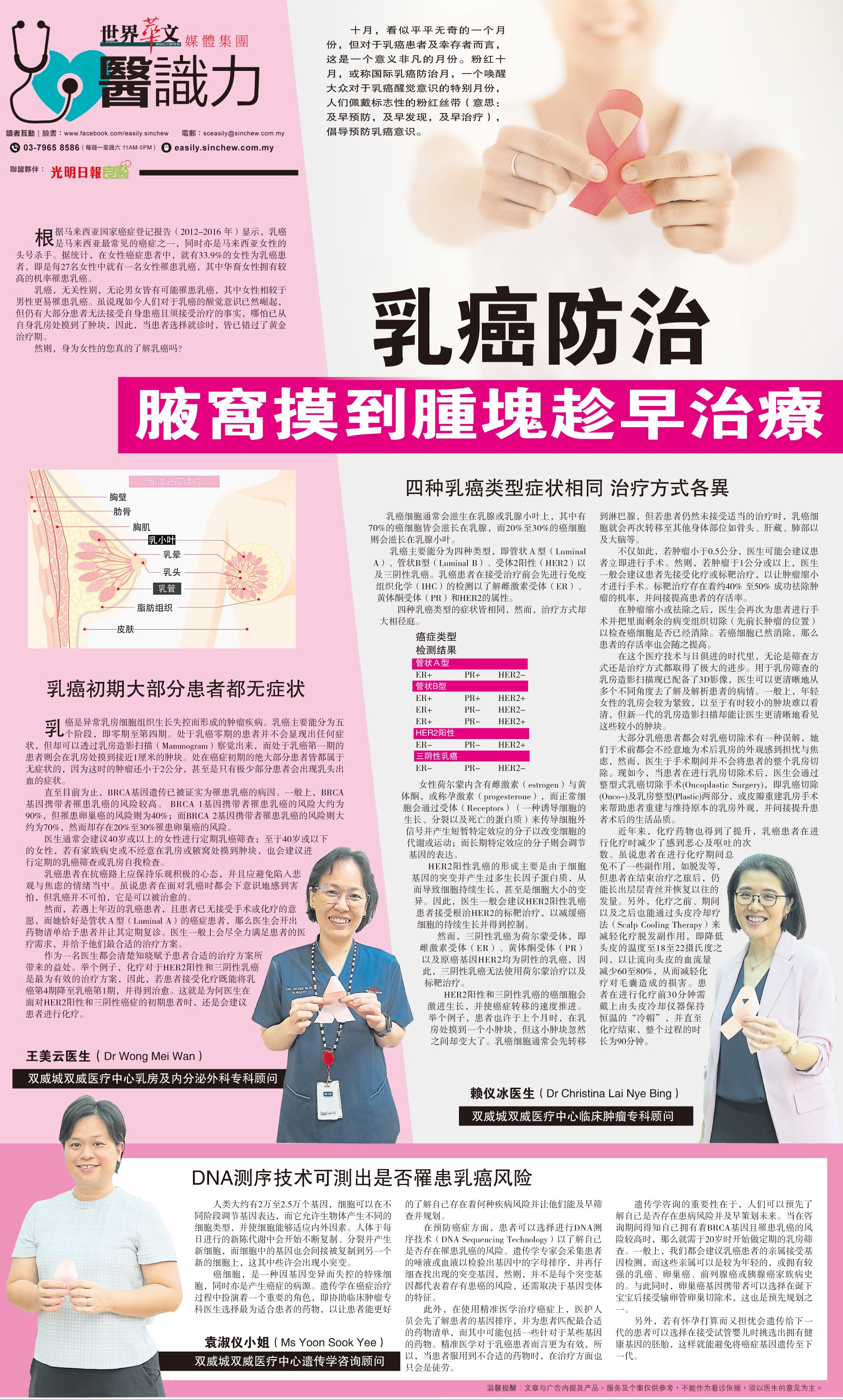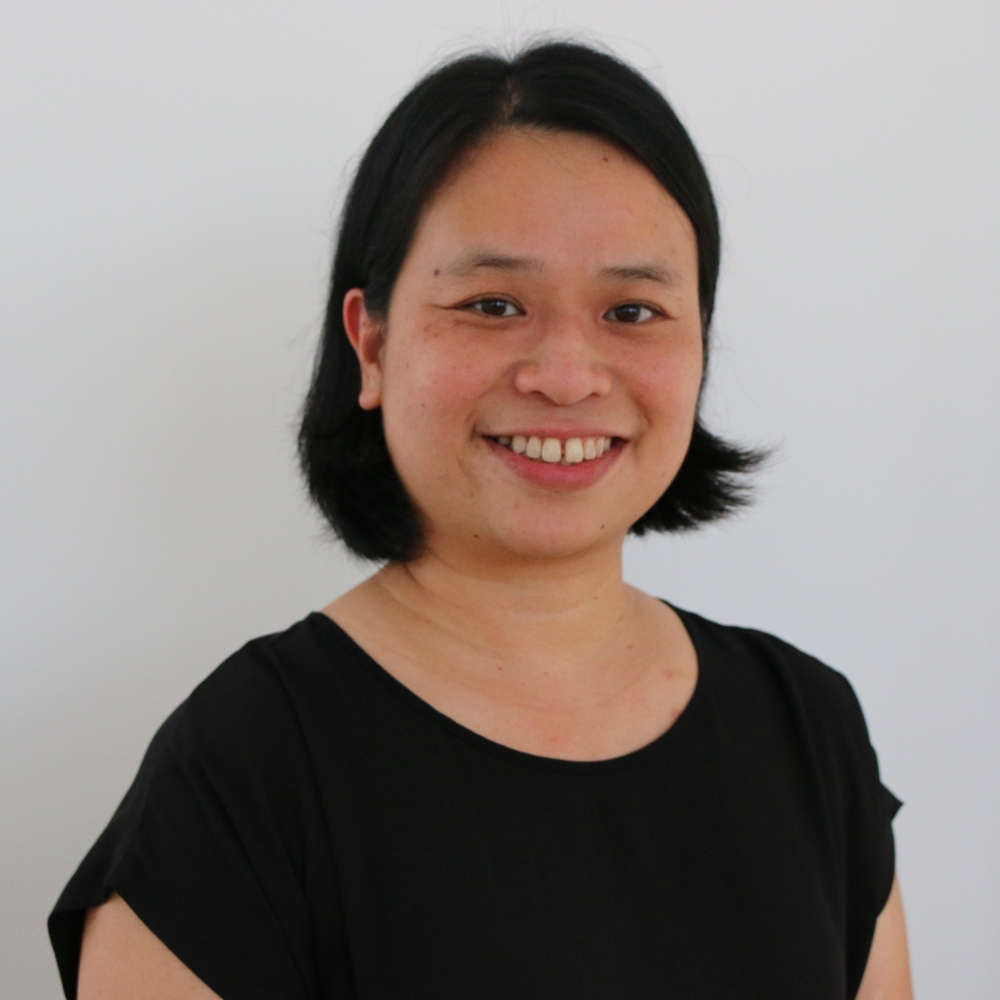Breast Cancer Prevention and Treatment - Feeling a Lump In The Armpit and Treating It Before It's Too Late
25 October 2023

October may seem like an ordinary month, but for breast cancer patients and survivors, it's a month of great significance. Pink October, or International Breast Cancer Awareness Month, is a special month to raise awareness of breast cancer, with people wearing the iconic pink ribbons (meaning: early prevention, early detection, and early treatment) to promote breast cancer awareness.
According to the Malaysian National Cancer Registry Report (2012-2016), breast cancer is one of the most common cancers in Malaysia and is also the number one killer of women in Malaysia. According to statistics, 33.9% of female cancer patients are breast cancer patients, which means that 1 in 27 women suffer from breast cancer, with Chinese women having a higher chance of suffering from breast cancer.
Breast cancer is a gender-neutral disease that affects both men and women, and women are more susceptible to breast cancer than men. Although people have become more aware of breast cancer, most of the patients are still unable to accept the fact that they are suffering from cancer and need to undergo treatment, even if they have already felt a lump in their breasts, therefore, when they choose to seek medical treatment, they have already missed the golden period of treatment.
However, as a woman, do you really know about breast cancer?
Dr Wong Mei Wan, Consultant Breast and Endocrine Surgeon, Sunway Medical Centre, Sunway City.
 Breast cancer is a tumour disease that develops when abnormal breast cells and tissues grow out of control. Breast cancer can be divided into five stages, i.e. stage zero to stage four. Patients with stage zero breast cancer do not show any symptoms, but can be detected by mammogram scanning, while patients with stage one breast cancer will feel a lump close to 1 cm in the breast. The majority of patients in the early stages of cancer are asymptomatic, as the tumour is still less than 2 centimetres, and only a very small percentage of patients may even experience bleeding from the nipple.
Breast cancer is a tumour disease that develops when abnormal breast cells and tissues grow out of control. Breast cancer can be divided into five stages, i.e. stage zero to stage four. Patients with stage zero breast cancer do not show any symptoms, but can be detected by mammogram scanning, while patients with stage one breast cancer will feel a lump close to 1 cm in the breast. The majority of patients in the early stages of cancer are asymptomatic, as the tumour is still less than 2 centimetres, and only a very small percentage of patients may even experience bleeding from the nipple.
Up till now, the inheritance of the BRCA gene has been proven to be a cause of breast cancer. In general, carriers of the BRCA gene have a higher risk of developing breast cancer. Carriers of the BRCA 1 gene have about a 90% chance of developing breast cancer and a 40% chance of developing ovarian cancer, while carriers of the BRCA 2 gene have about a 70% chance of developing breast cancer and a 20% to 30% chance of developing ovarian cancer.
Doctors usually recommend regular breast cancer screening for women aged 40 or above. For women aged 40 or below, regular breast cancer screening or breast self-examination will also be recommended if they have a family history of the disease or if they inadvertently feel a lump in their breasts or armpits.
As a doctor, we are well aware of the benefits of empowering our patients with the right treatment options. For example, chemotherapy is the most effective treatment option for HER2-positive and triple-negative breast cancers, so if a patient receives chemotherapy they can be cured of both stage 4 breast cancer down to stage 1 breast cancer. This is why doctors recommend chemotherapy to patients in the early stages of HER2-positive and triple-negative cancers.
Dr Christina Lai Nye Bing, Consultant Clinical Oncologist, Sunway Medical Centre, Sunway City.
 Breast cancer cells usually grow in the galactophore or in the lobules, with 70% of the cancer cells growing in the galactophore and 20% to 30% in the lobules.
Breast cancer cells usually grow in the galactophore or in the lobules, with 70% of the cancer cells growing in the galactophore and 20% to 30% in the lobules.
Breast cancer can be categorized into four main types, namely Luminal A, Luminal B, Receptor 2 Positive (HER2) and Triple Negative. Breast cancer patients will undergo immunohistochemistry (IHC) testing for estrogen receptor (ER), progesterone receptor (PR), and HER2 properties before receiving treatment.
Female hormones contain estrogen and progesterone, while normal cells transmit extracellular signals through receptors (proteins that induce cell growth, division, and death) and produce molecules with transient, specific effects that alter cell metabolism or movement, and molecules with long-term, specific effects that regulate gene expression.
HER2-positive breast cancer develops mainly due to the mutation of cell genes and the production of too many growth factor proteins, which leads to the continuous growth of cells and even the variation of cell size. Therefore, doctors usually recommend HER2-positive breast cancer patients to receive targeted therapy to eradicate HER2 in order to slow down the continuous growth of the cancer cells and get it under control.
However, triple-negative breast cancer is a hormone receptor, i.e., estrogen receptor (ER), progesterone receptor (PR), and proto-oncogene HER2-negative breast cancer, and therefore, hormone therapy as well as targeted therapy is not available for triple-negative breast cancer.
Ms Yoon Sook Yee, Genetic Counsellor, Sunway Medical Centre, Sunway City
 Human beings have about 20,000 to 25,000 genes, and cells can regulate gene expression at different stages, which allow organisms to produce different cell types and enable cells to adapt to internal and external factors. During the daily metabolism of the human body, new cells begin to replicate, divide, and produce new cells, and the genes in the cells are indirectly copied to another new cell, with some minor mutations.
Human beings have about 20,000 to 25,000 genes, and cells can regulate gene expression at different stages, which allow organisms to produce different cell types and enable cells to adapt to internal and external factors. During the daily metabolism of the human body, new cells begin to replicate, divide, and produce new cells, and the genes in the cells are indirectly copied to another new cell, with some minor mutations.
Cancer cells, which are specialised cells that have become uncontrolled due to genetic mutations, are also the source of cancer. Genetics plays an important role in the treatment of cancer by assisting clinical oncologists in selecting the most appropriate medications for their patients, so that patients can better understand their risk of the disease and can be screened and planned for at an earlier stage.
In terms of cancer prevention, patients may choose to undergo DNA Sequencing Technology to find out if they are at risk of developing breast cancer. Geneticists will collect saliva or blood from the patient to check the alphabetical order of the genes and look for mutations, however, not every mutation indicates a risk of cancer, it depends on the characteristics of the gene variant.
In addition, to use precision medicine to treat cancer, healthcare professionals will first understand the genetic sequencing of the patient and match the patient with a list of the most appropriate medications, which may include some medications that target certain genes. Precision medicine is more effective for breast cancer patients. So, when a patient is given an inappropriate medication, it will be futile in terms of treatment.
Source: Sin Chew Daily





